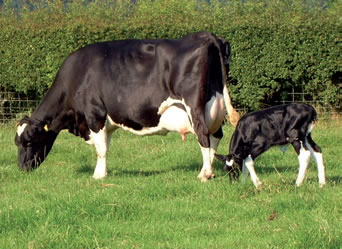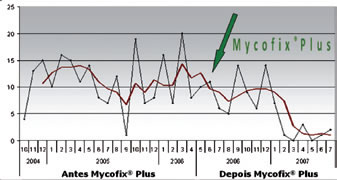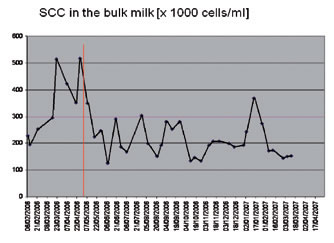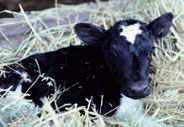Solving Mycotoxin Related Problems in Dairy Cows
Although ruminants are known to be less susceptible to mycotoxins than monogastric animals, extensive literature details the negative impacts of these hazardous substances on the health, reproductive and production parameters of dairy cows. It is true that some mycotoxins (mainly trichothecenes) are detoxified to some degree by rumen microorganisms; however, metabolites from others (i.e. zearalenone) can be equal or more toxic than the parent mycotoxin. High yielding dairy cows are fed high energy rations often containing higher levels of concentrates, and they have greater dry matter intakes. This may lower rumen pH and will increase the rate of passage of digesta through the digestive tract. Obviously, this will diminish the time available and conditions for ruminal detoxification of mycotoxins. Reproductive performance and milk yield are related parameters; therefore, getting cows bred back, maintaining a normal lactation cycle, and maintaining normal milk production are important to milk yield and the economic success of dairies. Factors disrupting reproductive cycles and factors which depress milk production have a negative economic impact. Zearalenone negatively impacts reproductive efficiency and trichothecenes adversely affect rumen microorganisms, depress feed intake and feed efficiency, and reduce milk production. Measures which counteract these mycotoxins are available as shown in the results of the field trial reported in this publication.

The objective of this trial was to study the effect of Mycofix® Plus on dairy cows fed naturally contaminated feed in terms of performance and health parameters. A dairy herd located in Côtes d'Armor, France, was experiencing multiple problems including reduced productive performance and poor health status which led to the mycotoxins analysis of the feed. The problems registered in the herd prior to the treatment included high incidence of diarrhea in calves, lowered feed intake, poor body condition scoring, poor fertility and high abortion rate, high mastitis incidence, high somatic cell count (SCC) in the bulk milk and reduced milk production. The analysis of the feed was performed at a certified laboratory and showed the following results:
Table 1 - Results of mycotoxin analysis
| Mycotoxin | Contamination [ppb] |
| B-Trichothecenes | 1025 |
| • Nivalenol | 35 |
| • Deoxynivalenol | 750 |
| • 15-o-acetyl-deoxynivalenol | 240 |
| Zearalenone | 120 |
Table 2 - Reproductive Parameters (number of artificial inseminations (AI))
| Period | No. AI | No. 1st AI | % successful 1st AI | No. 3rd and + AI | % 3rd AI | Average no. of AI | No. days between calving and AI |
| Spring – Summer 05 | 23 |
8 |
35 |
11 |
48 |
3.2 |
188 |
| Winter – Spring 05-06 | 16 |
5 |
31 |
6 |
35 |
3.0 |
165 |
| Beginning Mycofix® | 11 |
1 |
9 |
6 |
55 |
3.4 |
160 |
| Summer 2006 | 11 |
3 |
27 |
5 |
45 |
2.5 |
145 |
| Autumn – Winter 06 | 7 |
3 |
43 |
4 |
29 |
1.9 |
126 |
Table 3 - Treatment Costs
| Reproduction | Mastitis | Antibiotics | Anti-inflammatory | Metabolic disorders | Total | |
| Treatment costs (10 months without Mycofix® Plus) [EUR] | 949.65 |
1078.32 |
1053.31 |
387.12 |
178.30 |
3605.00 |
| Treatment costs (10 months with Mycofix® Plus) [EUR] | 346.82 |
841.19 |
166.34 |
200.43 |
130.06 |
1712.21 |
| Difference [EUR] | -602.83 |
-237.13 |
-886.97 |
-186.97 |
-48.24 |
-1892.79 |
Trial Design:
The trial was performed in a dairy herd having 50 Holstein cows with an average production of 9000 kg milk/animal/year. The cows were fed a Total Mixed Ration (TMR) with 50% of maize. Mycofix® Plus was added to provide 25 g/cow/day in the TMR and fed to the whole herd. The trial was started on the 1st of May 2006.
Results:
The results achieved after the inclusion of Mycofix® Plus in the feed were compared to the results of the previous months (offon trial design).
The following parameters were measured:
- Mastitis incidence (Figure 1);
- Somatic Cell Count (SCC) in bulk milk (Figure 2);
- Feed intake (Table 4);
- Reproductive performance (Tables 2 and 3).

Figure 1 - Incidence of mastitis registered per month: Black line – total number of mastitis; Red line – average 4 months (OBS: not all the cases of mastitis were registered and therefore they are not included on the chart, especially in periods with high incidence of the problem, namely the first quarter of 2006).
Mastitis affected about 20 cows in some months prior to the use of Mycofix® Plus. The incidence of mastitis was immediately reduced with the beginning of the treatment in May 2006.

Figure 2 - Somatic cell count in bulk milk (OBS: in the control period (before MPL use), milk with too high SCC was discarded, thus reducing the disparity of the chart).
The SCC, prior to adding Mycofix® Plus, was very high, reflecting a high incidence of mastitis problems in the cows. The inclusion of Mycofix® Plus in the feed also reduced SCC. The spike in SCC, which occurred in January 2007, was due to a problem in by-pass protein in the feed.
Table 4 - Feed Intake
| Month | Feed intake (kg) |
| April 2006 | 20.7 |
| July 2006 | 23.7 |
| August 2006 | 24.0 |
| January 2007 | 23.7 |
Feed intake was improved throughout the trial with the Mycofix® Plus treatment, achieving a level of 23.7 kg/cow/day in January 2007.

The average number of inseminations was lowered from 3.4 to 1.9 by using Mycofix® Plus. The low conception rates before the treatment is indicated by the high percentage of 3rd artificial inseminations. First insemination conceptions improved from 9% prior to feeding Mycofix® Plus to 43% in Autumn-Winter 2006, which clearly shows the improvement in reproductive efficiency. Parallel to this, the number of cysts decreased and the heats were described as more regular. The rate of non-return to heat, which increased from 29 to 49%, reflects the higher insemination success, thus a higher conception rate (information not displayed on the table).
Economic Calculations:
The treatment costs totalled 3,605 € before the use of Mycofix® Plus from which the major expenses were derived from antibiotic treatments of mastitis. A total of 1,892.79 € could have been saved by the inclusion of Mycofix® Plus due to the reduction in cases of mastitis.

Figure 3 – Annual milk losses due to mastitis
The scheme in figure 3 shows the profit lost due to discarded milk from cows with mastitis and excessively high SCC. One case of mastitis results in 6 days of discarded milk. Without the Mycofix® Plus treatment this farm was losing 5,376 €/year due to the high occurrence of mastitis. When Mycofix® Plus was included in the diet, 4,840 € was added to the profit due to the substantial reduction in mastitis and a considerable decrease in discarded milk.
Table 5 - Economic calculations
| [EUR] | |
| Increased milk sold | (+) 5 800 |
| Decreased veterinary costs | (+) 2 280 |
| Decreased penalties (SCC) | (+) 900 |
| Total | (+) 8 980 |
Table 5 clearly shows that the investment made on approximately 500 kg of Mycofix® Plus per year generates a profit of almost 9,000 €.
ConclusionAs the results show, the inclusion of Mycofix® Plus to the ration fed at this dairy farm, which contained mycotoxin contaminated ingredients, improved the health, reproductive and performance parameters. The addition of 25 g/cow/day of Mycofix® Plus to the ration counteracted the negative effects of the mycotoxin contamination of 1025 ppb trichothecenes and 120 ppb zearalenone. The high mastitis incidence, high somatic cell count, low feed intake, poor fertility rate and expensive treatment costs were improved, showing that feeding Mycofix® Plus is efficacious and cost effective. Finally, by economic analysis, it can be easily assessed that the annual investment on Mycofix® Plus will generate profits that will definitely overcome the expenses.
For more information please visit www.biomin.net







 BIOMIN Holding GmbH
BIOMIN Holding GmbH +43 2782 803 0
+43 2782 803 0






